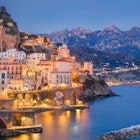
Oct 17, 2024 • 10 min read
Naples, Italy's third-largest city, thrives on contradictions. As one of the oldest continuously inhabited urban areas in the world, Naples is both chaotic and cultured, opulent and gritty, exuberant and understated, with architectural gems to discover around every corner.
Founded by Greeks in the first millennium BCE, Naples has witnessed over 2500 years of history unfold from its magnificent perch along the Mediterranean Sea, with Mount Vesuvius looming in the distance.
{
"url": "things-to-know-before-traveling-to-naples",
"destination": "Naples",
"continent": "Europe",
"country": "Italy",
"city": "Naples"
}We can thank Naples for inventing pizza, but culinary delights abound, and caffè culture is found in its many charming coffee bars. Many tourists skip Naples as they make their way to the Amalfi Coast or Pompeii archeological park, but this intriguing city, with its captivating architecture, rich history, and mouth-watering culinary traditions, is not to be missed. Here's everything you need to know before your trip to Naples, Italy.

The best time to visit Naples is in the late spring, before the summer crowds arrive, or the early fall when the hectic tourist season has come to a close, yet the weather is still sunny and warm. Though winter is less crowded, offering more opportunities to meet the locals, the weather can be rainy.
The Christmas season is hectic in Naples, but the many festivities and holiday traditions, including the Neapolitan tradition of creating elaborate presepe (nativity scenes), make it worth a visit despite the holiday crowds.
If it's your first visit to Naples, consider staying in the bustling "Centro Storico," the heart of Naples. Naples' entire central district is a UNESCO World Heritage Site, complete with cobbled streets, elegant palazzos, and historic churches around every corner.
{
"url": "things-to-know-before-traveling-to-naples",
"destination": "Naples",
"continent": "Europe",
"country": "Italy",
"city": "Naples"
}For a more relaxed stay, Chiaia, Naples' seafront neighborhood, offers luxe hotels with stunning views of the Mediterranean Sea. Chiaia is best known for its many independent fashion boutiques, but you'll also find high-end shops here such as Prada and Armani.
Families will enjoy a stay in Posillipo, a quieter, more residential neighborhood located along the northern coast of the Gulf of Naples. Posillipo is home to several beaches and parks. Don't miss Virgiliano Park, a green oasis in the city where terraces overlooking the whole Gulf of Naples offer vistas of the beautiful islands of Ischia, Capri, and Procida.
Italian is the official language in Naples. That said, most people in Naples and Campania speak the lively Napolitano (Neapolitan) regional dialect. You'll find English spoken in most hotels and restaurants, but pack an Italian phrasebook and learn a few key phrases before your trip so you can communicate with locals.

The Euro is the official currency of Naples and the rest of Italy. Credit cards (Visa and Mastercard) are widely accepted, but street market vendors, taxi cab drivers, smaller shops, and eateries may not accept credit cards and usually prefer to be paid in cash. Tipping is not standard in Italy, but it is common to add about €1 per diner to tip restaurant waitstaff for good service or round up the bill. At a bar, for example, leave 1 Euro for an 80 cent espresso.
Naples' main tourist attractions are centered along the seafront and Centro Storico, so it's easy to get around on foot. The city has an extensive public transportation system with Metro trains, buses, trams, and even funiculars (incline railways) that transport rides up prominent hills in the city. Regional trains connect visitors to Pompeii, Herculaneum, and towns on the Amalfi Coast, including Sorrento. Naples International Airport is connected to the city by bus.
Renting a car in Naples isn't advised since parking is scarce, the narrow, one-way streets can be challenging to navigate, and traffic is always an issue, so opt for walking or taking public transportation. Taxis are plentiful, but never enter one without negotiating the price beforehand to avoid being overcharged.
{
"url": "things-to-know-before-traveling-to-naples",
"destination": "Naples",
"continent": "Europe",
"country": "Italy",
"city": "Naples"
}
If you plan to spend a lot of time sightseeing in Naples, save money with a Naples ArteCard. The pass includes free admission to up to three museums and a 50% discount admission to attractions thereafter, plus free travel on all public transportation. Some attractions have limited capacity, so you may need to book a few visits in advance. The ArtePass also includes tourist sites and museums outside of Naples, in the surrounding region of Campania, including museums in Pompeii.
You can buy it online and receive it immediately via email or app, but be sure to activate it manually on first use at any UnicoCampania transport network turnstile or at the ticket office of any participating museum. Visitors aged between 18 and 25 will save even more money with the Naples ArtePass 3 days Young pass.
Naples is generally safe to visit, and most major U.S. cities outrank Naples in terms of crime levels. Violent crime is rare, but petty crime remains an issue. Pickpockets can be a problem in crowded places, around tourist landmarks, on the metro and at train stations, so keep your belongings secured in a money belt.
In the case of a medical emergency, dial the free number 118 anytime, anywhere in Italy, to request emergency assistance or an ambulance. Finally, Mount Vesuvius is an active volcano, and earthquakes are also possible, so keep an eye on the news before your trip.
You might also like:
Italy's best dishes and where to try them
Where to find your favourite pasta shapes
Eat Italy: learn about Italian food culture with this Lonely Planet's book
{
"url": "things-to-know-before-traveling-to-naples",
"destination": "Naples",
"continent": "Europe",
"country": "Italy",
"city": "Naples"
}
Solo Travel
20 expert solo travel tips for women from the Lonely Planet teamOct 31, 2024 • 11 min read

Oct 17, 2024 • 10 min read




Jul 1, 2024 • 4 min read

Jun 13, 2024 • 8 min read


Apr 7, 2024 • 10 min read
